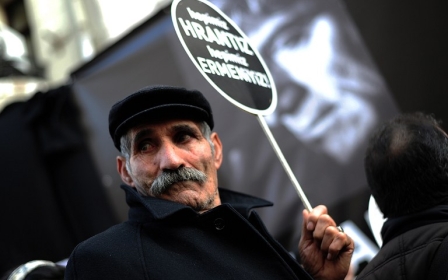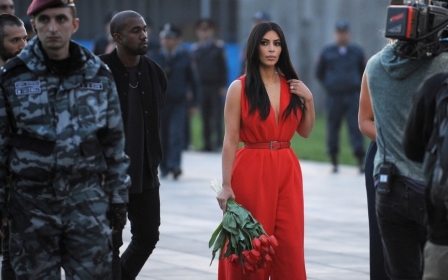Armenian community drawn into Jerusalem’s tensions

JERUSALEM - On 6 April, 2015, Armenian singer and writer Apo Sahagian took on the Times of Israel’s blog to report an incident where young Jewish extremists attacked a group of Armenian seminary students in the Old City of Jerusalem.
Religious members of the Armenian community are regularly the targets of sometimes-violent provocations. As members of the Palestinian Christian community, they are being targeted because of their religion. The patriarchate is making a point in remaining neutral in the Israeli-Palestinian conflict while the youth, according to Sahagian, is turning toward Armenia.
“Take the beating”
“Spitting is the most common, especially against priests and seminary students, because they stand out,” Sahagian said, seated in the sun outside of the American colony’s bookshop in East Jerusalem. Apart from music for his band Apo and the Apostles, Sahagian, in his twenties, regularly writes on his relationship with Armenia and his identity, in Armenia weekly notably. “My article was only to raise police awareness. Occasional consideration for the Armenians is not a bad thing (…). I was really trying to bring it to a Jewish audience.”
In his column, Sahagian describes an incident in which young Armenian seminary students got punched by young Jewish extremists. “At least 20 police officers illegally entered the seminary to apprehend two students whom they accused of giving a black eye to one of their attackers,” Sahagian wrote.
“When they respond, the police would go and arrest the Armenian guy first without corroborating any truth,” he said. For him, the fact that the students are Armenians is also playing to their disadvantage - the Israeli Jewish youth will always have the benefit of the doubt over non-Jews. This double standard seems to be fully understood by the Armenian community. Sahagian wrote: “It has reached the point where I overheard someone say to one of the seminary students: 'Take the beating. If you react, they will arrest you. You are not Jewish'.”
For Hovnan Baghdasaryan, an Armenian priest and member and secretary of the Holy Synod of the Patriarchate, the provocations are the act of a handful of Yeshiva students, hateful toward Christians. In his thirties, calm and thoughtful, he is also studying for a master's degree in international relations at the Hebrew University. He came here from Armenia at the age of 15 to study. His apartment, full of books and reminders of Armenia, is located inside the Patriarchate’s convent. Hidden behind heavy walls, the convent is just a few hundred metres from Jaffa Gate in Jerusalem’s old city, yet so quiet and peaceful that it seems kilometres away from the city’s noisy and crowded streets.
“There are some extremists, Yeshiva students who are aggressive, they not only attack but mock, and sometimes spit on the priests - that way they express their hatred toward the Christians,” he said soflty. “It’s common and many Israelis condemn this phenomenon. Non-religious or non-extremist Jews really do not accept this kind of behaviour of spitting, of being aggressive, of attacking Christians or clergymen.”
Attacks of a religious nature by Jewish extremists against Muslims and Christians alike are common in the West Bank, Jerusalem and Israel. Christian cemeteries and churches have already been the subject of price-tag attacks in recent years. In August 2014, "Death to Arabs and Christians and all those who hate Israel," was sprayed in Hebrew on the walls of the Assembly of Bishops at the Notre Dame Centre in East Jerusalem ahead of the Pope’s visit. A week later, a Romanian Orthodox church in Jerusalem was defaced with a graffiti saying: “Jesus is garbage.” Earlier this year, a building belonging to the Greek Orthodox Church was also set on fire in Jerusalem in what was described as a hate crime.
A week after the attack on the seminary students reported by Sahagian, vandals desecrated a Christian cemetery at the border with Lebanon. When 15 graves were vandalised in the Maronite village of Jish, in the Galilee, fingers were immediately pointed toward Jewish extremist groups.
A neutral Armenian community
If Sahagian refused to answer the comments in his column, he still paid attention to some of them. One commentator caught his attention, writing, according to Sahagian, that "the Armenians sided with the Palestinians’ genocide fight against the Jews (…)". The historical record suggests the opposite, he says. "I was actually told that during the 1948 war when the Jewish quarter was besieged, the Armenians opened the quarter to let the Jews pass through the quarter to safety [to the Jewish quarter].”
For him as for Baghdasaryan, being attacked by extremist Jews and accused of siding with the Palestinians is ironic at best. “The Armenian patriarchate of Jerusalem has very good relations with both the Israeli government and the Palestinian authority,” he said. “In all our history we have always been neutral in all clashes and conflicts.”
According to him, the relations with the Eastern European Jewish community and Armenia have also always been of tolerance and protection. “Some justify this behaviour by saying that because the Jews were treated this way in the past, so they have the right to do the same today (…). While they were being harassed in Ukraine and other parts of Soviet Union, Soviet Armenia was a safe shelter for them. Many Jews fled from Ukraine, Belarus etc… and settled in Armenia.”
If the Patriarchate officially remains on the bench in the conflict, Armenian civilians are navigating between Israelis and Palestinians depending on their social preferences.
“The Armenians living in Jaffa, Haifa and some in Petah Tikva, for them, there is no political question. They are Israelis, they were born Israelis,” said Sahagian. For those living in Jerusalem, being in contact with both Palestinians and Israelis on a daily basis tends to nuance their position. “Some Armenians identify with Israel (…), although it’s not in a political manner but more in a social manner (…). The political questions are kept for later because they also go to the West Bank, they hang out with Palestinian and they see the occupation there. So the political question is not a complicated one for them. Any Armenian will tell you: the occupation must end.”
Turned toward Armenia
For Sahagian, the shape that a possible state (or states) would take doesn’t matter so much for Armenian youth who are turned toward a homeland they are still in touch with. “For my father, my parents, Armenia was under the USSR so they didn’t grow up with an independent state of Armenia. I was born in 1990 so I grew up with the free republic of Armenia. It’s always on my mind. What’s happening in Armenia is always a priority.”
According to him, the relations remain tight within the diaspora. “Any community you go to, in the diaspora, the structure is very similar. We have youth clubs; they are pan-Armenian. The networking is very strong,” he enthusiastically explains. “Every summer, they do events in Armenia. You have 3,000-4,000 athletes from all over the world. Half Armenians, quarter Armenians, full Armenian… all of them. The connections are very strong.”
For Sahagian, the diaspora is just a phase that will eventually have to come to a closure, by going to settle once and for all in Armenia: “I just want to be financially strong, viable before going there. And I want to do it fast. I’m still young. If I put down roots here it’ll be harder.”
Middle East Eye propose une couverture et une analyse indépendantes et incomparables du Moyen-Orient, de l’Afrique du Nord et d’autres régions du monde. Pour en savoir plus sur la reprise de ce contenu et les frais qui s’appliquent, veuillez remplir ce formulaire [en anglais]. Pour en savoir plus sur MEE, cliquez ici [en anglais].




